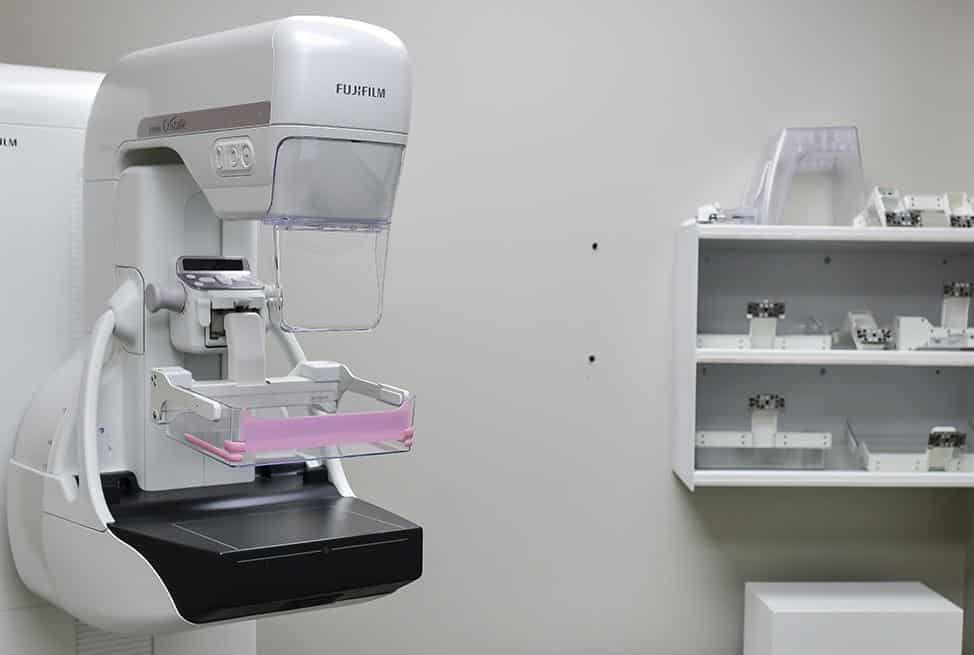Regular mammograms are the key to early breast cancer detection. While the majority of breast lumps discovered during the procedure turn out to be benign (not cancerous), a mammogram can help discover serious problems.
According to studies, women who participate in mammography screenings have a 41% reduction in the risk of dying from breast cancer. Unfortunately, common myths surrounding the procedure keeps many people from taking advantage of it.
One of these myths involves radiation. Let’s take a closer look at mammograms, radiation, and safety.
Importance of Radiation: How a Mammogram Works
A mammogram is an x-ray of a breast. It uses tiny doses of radiation (less than many x-rays) to detect a variety of breast problems, including benign tumors, cysts, and cancerous lumps. This screening allows doctors to discover breast problems before they can detect them by palpation.
When a malignant tumor is large enough to be palpable, it generally requires much more time-consuming treatment than a small lump. Meanwhile, discovering a tumor (even if it’s benign) during self-examination is a big stress for a woman.
That’s why regular mammograms are extremely important for preventing serious health issues. However, such precise detection isn’t possible without x-raying.
X-raying involves using external radiation to produce an image of a breast from the inside. To get an image, these rays must pass through the body. Today, x-ray equipment is highly advanced. It uses negligible doses of radiation to achieve top-notch screening results.
During a mammogram, you get a smaller dose of radiation than during a regular chest x-ray. Without radiation, this screening wouldn’t be available.
Close to None: The Amount of Radiation You Get During a Mammogram
How much radiation are you exposed to during a mammogram? Let’s look at the numbers.
- – The total dose of radiation received during a mammogram is 4 mSv (milliSievert – a standard measure of radiation doses).
- – The total dose of background radiation an average American receives in a year is 3 mSv.
- – A dose of radiation received during a CT scan is between 3 mSv and 10 mSv.
- – A dose of radiation received during a spine x-ray is about 5 mSv.
According to the FDA, the exposure to 10 mSv from x-rays or CT scans increases the risk of death from cancer by 0.05%.
So to increase the risk of dying from cancer by 0.05%, you’d need to do 25 mammograms…in a row.
Meanwhile, by saying “no” to mammograms, women may increase the risk of dying from breast cancer by 41%.
The numbers speak for themselves.
Saving Lives: The Importance of Regular Mammography Screenings
While it’s less common in younger patients, breast cancer is the leading cause of death for women in their forties. Mammograms play a major role in diagnosing cancer before it becomes lethal.
Breast cancer in young women is generally more biologically aggressive. Preclinical breast cancer has a 16% chance of spreading to lymph nodes within one year in a woman, who is in her forties. The same chance drops to 7% for women in their fifties and to 5% for women in their sixties.
That’s why it’s imperative for women in their forties to start doing regular mammograms and continue to do so for as long as possible.
Here are a few other factors to consider:
- – The accuracy of a mammogram is about 87% (it correctly identifies 87 out of 100 women who truly have breast cancer).
- – Four out of five women older than 40 agree that mammograms are important. Unfortunately, only about half of them schedule screenings. With COVID-19 forcing many people to delay regular mammograms, the numbers are down.
- – A mammogram is currently the only test proven to reduce deaths due to breast cancer.
The minuscule amount of radiation you can get during a mammogram is a fair tradeoff for the benefits it offers.
To Do or Not To Do: Other Myths about Mammograms
Besides radiation-related misconceptions, women are exposed to a number of other myths about mammograms. Let’s debunk a couple of them.
Myth#1: If you don’t have a family history of breast cancer, you don’t need regular mammograms.
Debunked: Only about 5% to 10% of breast cancers are hereditary. It’s impossible to predict your chances of getting breast cancer by studying your family history. But you can detect malignant tumors at the earliest stages by doing a mammogram.
Myth#2: If you don’t feel any lumps during self-examination, you don’t need a mammogram.
Debunked: When malignant tumors start forming, it’s impossible to palpate them. Even an experienced doctor can miss a small lump. A mammogram won’t.
Myth #3: Mammograms are expensive and time-consuming.
Debunked: Medicare, Medicaid, and the majority of insurance companies covers mammograms. The appointment only takes 15 – 20 minutes. The mammogram itself is rarely longer than five minutes.
Myth #4: The COVID-19 pandemic is a good reason to reschedule a mammogram for next year.
Debunked: The risks of delaying screenings during the pandemic are higher than the risk of getting COVID-19 when visiting a clinic that takes all the necessary precautions.
Myth #5: Mammograms hurt.
Debunked: While it’s not a pleasant procedure, a mammogram isn’t painful. You may experience some minor and brief discomfort.
The Takeaway
A woman isn’t likely to avoid an x-ray if she breaks a leg. She wouldn’t shy away from a CT scan if her back hurt. However, millions of women around the world ignore regular mammography screenings due to a variety of myths, the absence of time, and a lack of information.
The amount of radiation from mammograms is tiny. You would need to do the screenings daily to increase your chances of dying from cancer by less than a percent. Meanwhile, by fitting regular screenings into your schedule, you can reduce these risks by 41%.
If you’d like to stay in control of your health, schedule a mammography screening today. At Women’s Imaging Specialists, we use the latest equipment to keep radiation from mammograms to a minimum.



